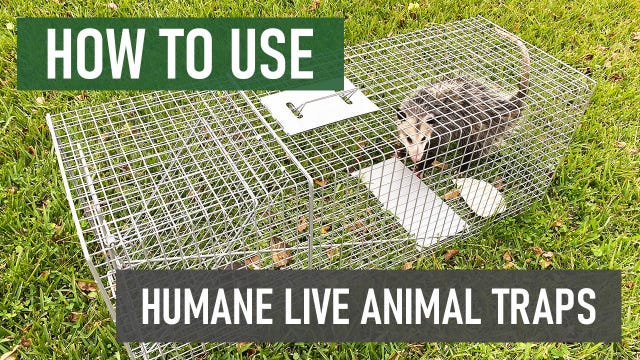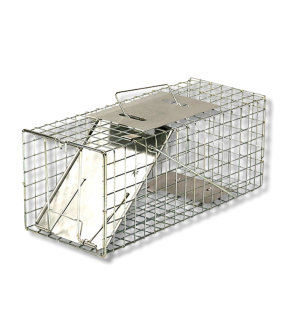Gain access to personalized product screening, the best pricing, rewards, and more!
Most Effective Products
How to Trap a Fox with a Live Trap
Foxes are intelligent creatures that can cause damage to your property. One method of removing a fox from your property is using a live trap to catch and release the animal. Live trapping is a safe and effective way to keep animals away from your home.
If you want to trap a nuisance fox with a live trap, read this guide for instructions and product recommendations.
Identification

Before using a live trap, you must ensure that the wild animal you are dealing with is a fox. This will ensure that you are using the correct bait and strategies.
Foxes are generally 32 to 50 inches long, including their bushy tail. They normally weigh between 7 and 15 pounds and are intelligent animals. Foxes resemble dogs and can be either red or gray in color. They are most active during dawn and dusk and are predators. They mainly feed on small creatures, as well as fruits and vegetables.
Use the image and description above to confirm that you are dealing with a fox on your property.
Inspection
Once you've confirmed that your pest animal is a fox, proceed with an inspection to determine the areas where the fox is most active. This is where you will place your live trap.
Where to Inspect
You want to pick areas that have high activity from foxes. These animals are most likely searching your property for food. Areas where trash is stored, as well as any vegetation, will most likely be spots where foxes are most active. If your property is near a wooded area or a body of water, foxes might also be near these areas.
What to Look For
Certain signs signal fox activity, such as fox dens, damaged gardens, stolen eggs from chicken coops, strong-scented urine, and fox tracks. These tracks will look like dog tracks, with four toes and claws on each paw.
Treatment
Now that you've identified your pest animal as a fox and noted areas where it is most active, you can use your live trap. Wear gloves when handling the trap to prevent leaving your scent. If a fox picks up a human scent on the trap, it will avoid the fox trap, which will make it ineffective.
Step 1: Remove Food Sources

You want the fox to enter the live trap with the help of bait. Because of this, competing food sources need to be removed. Keep your trash sealed in trash bags and stored in trash bins with a lid to keep it closed. Any pet food or bowls of water should be placed inside as soon as possible as well.
Step 2: Place the Trap

By now, you should have taken note of areas with high fox activity. These areas are where you will put your trap. Be sure to place your trap on an even surface. A fox might push or knock over the trap to reach the bait inside. Place a brick or weight on top of the trap to avoid this.
Step 3: Bait and Set the Fox Trap

Using the proper bait will increase your chances of catching a fox. These animals prefer eggs or raw meat. The bait should be placed near the back of the trap. This ensures the fox must step on the trigger plate to reach the food.
You will then set your trap by pushing on the door lock and lifting the door plate. Keep the door plate lifted while pulling the trigger arm forward to set it. You will know it is set when the trigger arm's hook catches the door.
Step 4: Monitor the Trap
You will need to check the traps twice a day, preferably once in the morning and once in the evening. This is when you will refill bait if needed. Checking the trap frequently may dissuade foxes from approaching the trap. Do not keep an animal trapped in the cage for 24 hours.
Step 5: Relocate the Fox
Any non-target animals should be released immediately. Once you have captured a fox in your live trap, check with your local authorities to ensure you correctly relocate the animal. Approach the trap slowly and use a gentle voice. Place a towel over the cage to avoid frightening the fox. Once you have relocated far enough, carefully open the trap and release the animal. You can read more about releasing an animal from a live trap here.
Prevention
Once the fox has been captured with the live trap, you want to ensure that wild animals do not invade your property again. You can take some preventative measures to keep your area fox-free.
Sanitation
Be sure to place all waste in a trash can, preferably with a lid to keep it closed. Remove all clutter and debris from your property since foxes may be drawn to nest and burrow in these areas. Any potential food or water sources, especially pet food, should be properly sealed in a container and stored indoors.
Exclusion
If your property is near a wooded area and you have no fencing, you are more susceptible to foxes and other wild animals invading it. Consider blocking off your property with fencing. To avoid foxes from disturbing your poultry, leave live traps near the chicken coop. If you catch more foxes, relocate them using the steps above.
Key Takeaways
What are Foxes and Why Are They A Problem?
- Foxes are intelligent animals that are most active at dusk and dawn. They resemble dogs and have pointy ears and a bushy tail. Foxes mainly feed on small animals such as mice and chickens but will also consume fruits and vegetables.
How to Trap a Fox Using a Live Trap
- Bait the live trap with raw meat or eggs, placing them behind the trigger plate.
- Check the fox trap once in the morning and once in the evening. Once a fox is caught, check with your local authorities to ensure you safely and correctly release it.
Preventing Foxes From Coming Back
- Install fencing and leave live traps near areas with high fox activity, such as chicken coops, to prevent foxes from entering your property again.









